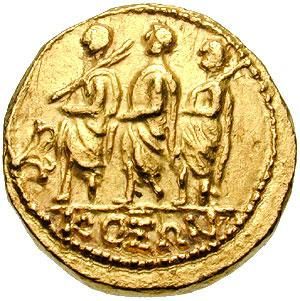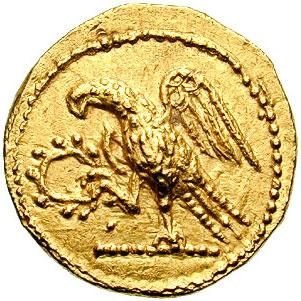Roman Brutus (44-42 BC)
Kool.ee-haridusportaal :: Roman Brutus (44-42 BC) Ei ole olemas kasutusjuhendit eluks. Õnneks on olemas www.kool.eeRoman Brutus (44-42 BC),Koolilaen, energialaen, matuselaen, matemaatika, ekool, e-kool, füüsika, ajalugu, seks, abort, laen
Roman Brutus (44-42 BC)

аверс

реверс
Coin is made of pure gold.
Obverse depicts three figures in togas, the middle one being Lucius Junius Brutus, an ancestor of Marcus Junius Brutus. Below the three figures is the word “Koson.”
The reverse pictures a Roman eagle perched on a scepter while holding a wreath of victory in one of its claws.
This is very similar to the type of motif found on many Roman Republic silver and gold coins. Even though these coins look very Roman, and were made to emulate Roman coins, they were made in Greece.
The photos are illustrative. Every coin design can differ a little.
Coin History
Roman Brutus (also Gold Stater of Brutus or Gold Stater of Koson) is one of the more controversial coins of the Ancient World. This coin was struck around 42 B.C., and embodies a story involving murder, war, and suicide.
44 B.C., Marcus Junius Brutus, Cassius and a group of Republicans assassinated Julius Caesar. This caused Civil War, and Brutus fled Rome to an area of Greece called Thrace where he raised an army of Dacian mercenaries awaiting the expected backlash of his actions. While in Thrace, Brutus attempted to gain financial backing. It was Polomocratia, the widow of the Thracian dynast Sadalas, who consigned gold to back the army of Brutus.
The Gold Staters of Koson were considered as military payroll for the army of Brutus, and were a part of his ‘War Chest.’ It is believed that all known examples of these coins in existence today originated directly from the ‘War Chest’ of Brutus’ army. A ‘War Chest’ is the payroll from which an army was compensated. Prior to battle the ‘War Chest’ would be buried to prevent its capture by the opposing armies. After the battle, the chest would be dug up and the soldiers would be paid.
After Brutus fled Rome, Octavian and Marc Anthony pledged to hunt down Brutus, and bring him to justice in an attempt to restore order and peace within the Roman Empire. They assembled their armies, and began their march.The allied forces of Octavian and Marc Anthony engaged the Dacian mercenary army of Brutus on the fields of Philippi. The battle was brutal and swift. With the defeat of Dacian army becoming emanate, and not wanting to be taken back to Rome in disgrace, Brutus rode onto the field of battle, and fell onto to his own sword thus ending his life. The ‘War Chest’ was lost and remained buried for over 2000 years.
Since these gold coins were buried soon after they were struck, most of them have survived in a pristine Mint State condition.
|
Размер |
Mы покупаем |
Mы продаем |
|
| 8.44 g |
- |
21 300.00 |
обновлено 27.03.2008
Hinnakiri võib olla AS Tavidis muutunud. Täpset hinda vaata siit

